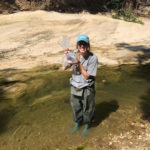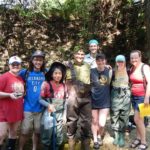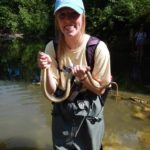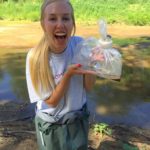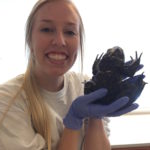Featuring our Graduating Seniors: Shelby McMillin
-
We here at the Siler Lab are proud of all our undergrads, especially those that have graduated and moved on with the skills they have learned while completing research in our department. Below is the first in the 2017 series: Shelby McMillin. Please also review graduating senior blogs from 2015 and 2016.
Like many of the other Siler Lab volunteers who have now graduated, my interest in herpetology was sparked by Dr. Siler, whom I met while taking his evolution course in the fall of 2014 at the University of Oklahoma. As a biology pre-med major, my interest in subjects like ecology, diversity, and evolution began long before my college career, which fueled my desire to take an evolution class at OU. I will never forget my experience on the very first day of Dr. Siler’s evolution class. He began by debunking some of the popular myths surrounding evolution, including the ideas that humans evolved from apes and that religion and evolution are incompatible. Following this first day, I knew our class was in capable hands. Dr. Siler has a unique ability to connect with his students on a personal level and inspire curiosity about the world around us, and it was this ability that motivated me to become involved in Dr. Siler’s lab as an honors student that next fall.
It just so happened that my first day volunteering in the lab coincided with another recently graduated senior’s first day: Liza Marhanka. We immediately became friends, volunteering in the lab on the same days of the week, learning alongside each other. While we were still new volunteers, we did things like tying tags in preparation for field season (a task that I mastered and enjoyed so much that I liked to challenge other volunteers to tag tying contests), completing data entry, and most importantly beginning the training process on procedures like DNA and tissue extractions that would give me the necessary experience to advance to quantitative polymerase chain reaction (qPCR) protocols further down the line.
One project at the lab that stood out to me was the production of Citizen Science Kits. Under the guidance of Jessa Watters, I was able to assist in making the kits that were then distributed to teachers across Oklahoma. The kits contain cotton swabs, vials, a permanent marker, and an Oklahoma frog identification guide with the intended purpose of Oklahoma teachers taking their students to a local pond or stream and allowing them the opportunity to identify species of Oklahoman frogs and to swab them for an infectious disease known as chytrid. This project was something I talked about during my medical school interview at OSU as something that allowed me to have a small hand in spreading awareness and educating the public—two tools that will be useful for me as a physician in the future.
Outside of lab work as a new volunteer, I had never been involved in any of the field work that is essential in herpetology research. Spending long periods of time outside and in streams and ponds searching for amphibians and reptiles was something that was outside of my comfort zone and made me nervous. I decided to completely immerse myself in the field work aspect when I enrolled in an OU Biological Station course taught by Dr. Siler and assisted by Jessa: Field Herpetology. During this two-week summer period, I spent the majority of my time knee-deep in streams and ponds, collecting herps and learning their scientific names with my classmates, which turned out to be an activity I really enjoyed. Having volunteered in the Siler lab for a year at this point, I was familiar with extracting tissues from individuals caught in the field and preparing them to become museum specimens for potential future research, allowing me to help my peers as they began to learn these processes for the first time, which was something I found to be extremely rewarding.
During my third semester as a volunteer in the lab in the fall of 2017, I shifted my focus to starting work on my honors thesis, which consisted of writing a scientific paper detailing the results of screening amphibians for chytrid that had been collected in central Oklahoma throughout various months in 2015, providing a basis for us to determine whether or not seasonal variation played a role in infection incidence and levels. Prior to this, I had very little experience writing papers for scientific journals, which I found to be hugely different from the type of writing I was accustomed to for my non-scientific courses at OU. Dr. Siler and Jessa mentored me throughout the entire process, and I am extremely grateful to both of them for walking me through the ins and outs of the process and helping me to submit my paper for publication in June 2017.
Lastly, in the spring of 2017, I got the opportunity to present my research at OU’s Undergraduate Research Day upon receiving funding from the Undergraduate Research Opportunities Program the previous semester. I was able to learn how to translate data into results and how to depict these results on a poster that could then be communicated to the scientific community. Additionally, I decided to enroll in a biology capstone (my final biology course taken as a senior) that focused on delving into the sixth extinction that some believe to be currently underway. To my surprise, the discussion on the very first day of capstone was centered around how chytrid is devastating amphibian populations worldwide, and it was even more impressed upon on me how the research we were doing at the Siler lab truly does have larger implications for the survival of amphibian populations all over the world. This is not simply a single issue applicable only to Oklahoma but rather a popular issue being researched by scientists all over the world in attempt to increase conservation efforts and to slow the spread of the disease. Following my final semester as a biology student and a student volunteer at the lab, I am happy to reflect on how thankful I am for all of the skills and knowledge passed along to me by Dr. Siler and everyone at the lab and how well they have equipped me for my endeavors at professional school in the near future!
Shelby is headed to medical school at the Oklahoma State University of Health Sciences in Fall 2017!! We wish her all the best.

